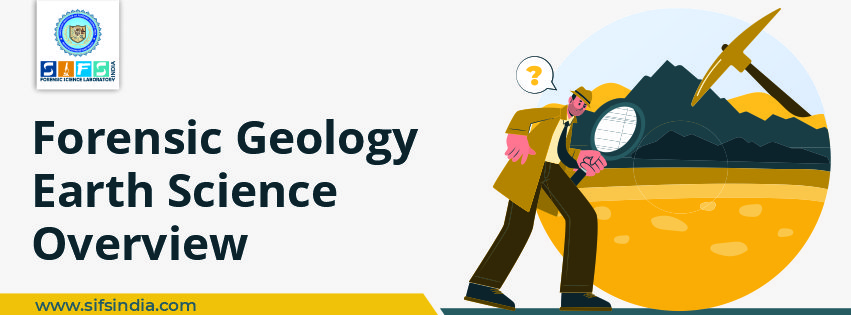Forensic geology is the methodical application of earth sciences to legal matters.
Practically, this means that a forensic geologist acknowledges, examines, and relates earth materials, such as soil, rocks, minerals, and fossils originate on a receptor (e.g., suspects/witness’s vehicle, clothing, etc.) to a possible source for an example crime scene or a point of disposal/release).
The main purpose involved behind such comparisons is to establish the degree of possibility that the material was or was not derived from a particular location; thereby, connecting or separating a person or object with that location.
In other cases, the comparison of earth materials is used to conclude the time an incident occurred, the cause of an incident, and/or responsibility for an incident.
Historical Overview of Forensic Geology
Recently, there had been an outbreak in the field of forensic geology throughout the world, but its traces can be jotted back to the mid-19th century.
The first case which was investigated in this field was done by Prof. Christian Gottfried Ehrenberg in 1856, he was asked to assist in the case of the Prussian railways, where silver had been stolen from barrels and replaced with sand.
He was an expert on diatoms and analyzed samples of sand with the help of a microscope that had been collected from different stations the train had passed and also identified them.
Later in the early 1900s, forensic geology was also adopted by Sir Arthur, in his Sherlock series.
Hans Gross and George Popp also contributed to the field of forensic geology through their investigative work.
All these were based on one of the most important principles of forensics which we now call the Locard Principle of Exchange. According to this, when two objects come in contact with each other, there is a mutual interchange of material that takes place from one article to the other.
These are the primary fundamental principles of trace evidence investigation, which continue to be valid in the present scenario.
Geological trace evidence analysis continued to be used in the field of police investigation till now.
It helps us in ascertaining whether the geological materials like minerals, soil, rock, fragments, or microfossils present on the body, clothing, or any asset of the culprit or suspect matches with that present on the crime scene, it also helps in identifying the place and time of the crime.
The United State Drug Enforcement Agency (USDEA) and the Federal Bureau of Investigation (FBI) uses the method of geological investigation from about the middle part of the 1900s till now.
A variety of analytical methods are used nowadays to identify different types of geological materials.
Apart from doing geological trace evidence analysis, forensic geologists also advise the police on search.
Forensic Geology Case Study
Georg Popp, a forensic scientist in Frankfurt, Germany, was asked to investigate the evidence in a murder case in which a seamstress called Eva Disch was strangled in a bean field with her own scarf in October 1904.
A filthy handkerchief had been left at the scene, and the nasal mucus on it contained fragments of coal, snuff particles, and, most intriguingly, grains of minerals, notably horneblende.
Karl Laubach, a suspect, was known to work part-time in a local gravel mining and full-time in a coal-burning gasworks.
Under the suspect's fingernails, Popp discovered coal and mineral grains, particularly the mineral horneblende. The suspect was also found to be a snuff user.
An examination of the soil extracted from Laubach's trousers revealed a lower layer in touch with the cloth whose minerals matched those identified in a sample taken from the site where Eva Disch's body was discovered!
A second soil type was discovered encrusted on top of this bottom layer.
The mineralogy and particle size of the minerals in the higher layer, notably a crushed mica grain, were comparable to soil samples gathered from the trail leading from the murder site to the suspect's residence, according to Popp.
Based on these findings, it was determined that the suspect scooped up the lowest dirt layer at the crime site, which was then covered by splashes of mica-rich mud from the walkway on his way home.
When presented with the soil evidence, Karl Laubach admitted to the crime, and headlines such as "The Microscope as Detective" appeared in Frankfurt newspapers at the time. It's impossible to say how a forensic geologist or a jury today would evaluate the geology evidence gathered by Popp from a distance of over a century.
One truth is undeniable: mineral analysis was employed in a real case, confirming Arthur Conan Doyle's prediction that geology would be used in criminalistics when he wrote the Sherlock Homes mysteries between 1887 and 1893.
Conclusion
Any component of geologic science that is exposed to public debate in a court of law is considered forensic geology.
Forensic geology is the application of geologic science's basic principles to the identification and evaluation of geologic materials that may be relevant to forensic issues.
These principles are also used in forensic geology to define the appropriate geologic context of a forensic scene or site.
Forensic geology is concerned with determining and substantiating conformity with processes, norms, and ethics in professional practice.
Involvement as an expert witness and the production of expert testimony related to geologic activity or circumstance are all part of forensic geology.
Any geologist working in a forensic setting must be aware of the legal parameters that constitute such a setting: For example, legal sufficiency, evidence chain-of-custody, and evidence gathering, preservation, and validation methods.

 June 06, 2021 - BY SIFS India
June 06, 2021 - BY SIFS India